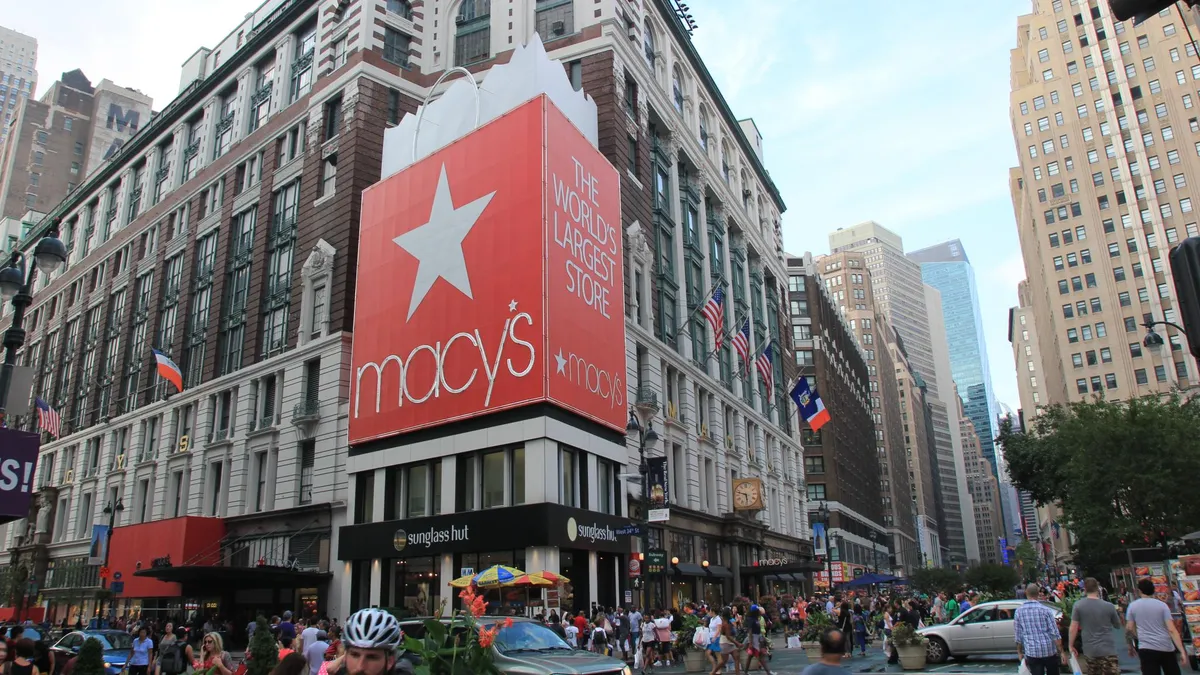Dive Brief:
-
Macy’s on Tuesday reported Q4 sales of $8.515 billion, down 4% from total sales of $8.869 billion in the fourth quarter of 2015. On an owned basis, Q4 same-store sales fell 2.7%, while Q4 same-store sales on an owned plus licensed basis fell 2.1%. For the fiscal 2016 year, sales were $25.77 billion, down 4.8% from total sales of $27.079 billion in fiscal 2015, the company said. On an owned basis, fiscal 2016 same-store sales were down 3.5% and on an owned plus licensed basis they fell 2.9%.
-
Macy's opened 27 stores and closed 66 stores in fiscal 2016, and said it’s on track to close another 34 stores in coming years. The new stores include a Macy’s store in Kapolei, HI, 24 of the company’s freestanding Bluemercury beauty retail stores, one off-price Backstage store in San Antonio, TX and a Bloomingdale’s Outlet in Orange, CA. All told, Macy's real estate activity generated some $675 million in cash, the retailer said.
-
Macy's expects sales to continue to decline in fiscal 2017, saying that same-store sales for this fiscal year on an owned basis will likely fall 2.2% to 3.3%, with same-store sales on an owned plus licensed basis to slide 2.0% to 3.0%. Total sales will likely fall 3.2 % to 4.3% overall, reflecting last year’s store closures.
Dive Insight:
Investors sent Macy’s shares up 1.9% Tuesday morning, mostly in reaction to the company's lucrative real estate position. “Macy's is looking more and more like a real estate play every day,” Nick Egelanian, president of retail development consultants SiteWorks International, told Retail Dive by email Tuesday. “It has valuable retail operations on the coasts, but very few sustainable stores in the interior of the country.”
As a department store retailer, Macy's continues to suffer from constant markdowns and inventory pile-ups, according to analysts from Jane Hali and Associates. “Their private label and exclusive brands, most with little name recognition, have done little to separate them from the competition,” according to a Hali note emailed to Retail Dive. “[They] appear to continually add lines without taking any away. The constant sale and excessive amount of inventory on their selling floors also commoditizes their offering.”
Macy’s is fighting that perception, according to statement Tuesday from CEO Terry Lundgren, though he too noted the importance of the company’s real estate portfolio.
“[W]e made significant progress on key initiatives that are starting to bear fruit. These include continued improvement in our digital platforms, the rollout of our new approach to fine jewelry and women’s shoes, an increase in exclusive merchandise and the refinement of our clearance and off-price strategy,” said Lundgren, who will step down Mar. 23, handing the reins to successor Jeff Gennette. (Lundgren will continue as executive chairman.) “We also took a big step forward in rightsizing our physical footprint and restructuring our entire organization.”
GlobalData managing director Neil Saunders agrees that Macy’s is suffering from its own lackluster merchandising approach, and warns that its real estate proceeds must be leveraged wisely. “[L]ike other players, Macy’s suffered from the reduction in traffic to malls across the holiday period. However, we also think that it did little to help itself with shops that remained, for the most part, uninspiring and badly merchandised. Against an exceedingly tough backdrop, Macy’s seems to be making very little effort on the shop floor — a position that does not bode well for the future,” Saunders said in a note emailed to Retail Dive.
“This monetization of assets provides Macy’s with a war chest that it can use to invest in improving its proposition. However, we believe that it is vital that this money is spent wisely and well," Saunders added. "It should not be used in a piecemeal way to simply smarten up existing stores, but to overhaul the whole customer experience and to reinvigorate the Macy’s brand. This is the last chance saloon for Macy’s: If it gets this wrong, it will increasingly find itself without the resources to implement a decent turnaround and will begin a downward spiral into oblivion.”
Egelanian concurs, noting that a scaled-down Macy’s could very well evolve into a strong department store retailer — but time is indeed running out. “I can see a 100- to 200-store chain of upscale coastal stores surviving, and perhaps even thriving, if the company moves fast now to shed hundreds of week stores, monetize most of its aging real estate fleet and invest in sharper more relevant upscale offerings in the surviving stores,” Egelanian said. “The window to execute on this strategy is very narrow, though.”














